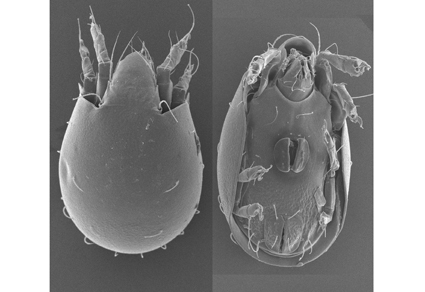Abstract
The family Symbioribatidae is recorded in Vietnam for the first time. Two new arboreal species of Symbioribates—S. bimorphus sp. nov. and S. tripartitus sp. nov.—are described, based on adults (males and females) collected from tree branches of Dipterocarpus alatus in Cat Tien National Park, Vietnam; the former species is sexually dimorphic, the latter species is the first non-sexually dimorphic representative within the genus. The generic diagnosis is presented. An identification key, distribution and habitats to the known representatives of Symbioribates are provided.
References
- Aoki, J. (1966) Epizoic symbiosis: an oribatid mite, Symbioribates papuensis, representing a new family, from cryptogamic plants growing on backs of Papuan weevils (Acari: Cryptostigmata). Pacific Insects, 8, 281–289.
- Bayartogtokh, B., Ermilov, S.G. & Corpuz-Raros, L. (2017) An interesting sexually dimorphic species, Neoribates isabelaensis sp. nov. (Acari, Oribatida, Parakalummidae) with remarks on sexual dimorphism in Oripodoidea. Zootaxa, 4347 (1), 94–108. https://doi.org/10.11646/zootaxa.4347.1.5
- Behan-Pelletier, V.M. (2015) Review of sexual dimorphism in brachypyline oribatid mites. Acarologia, 55, 127–146. https://doi.org/10.1051/acarologia/20152163
- Corpuz-Raros, L. & Ermilov, S.G. (2020) Catalogue of oribatid mites (Acari: Oribatida) from Continental Southeast Asia. Zootaxa, 4893, 1–216. https://doi.org/10.11646/zootaxa.4893.1.1
- Ermilov, S.G. & Gubin, A.A. (2022) Supplementary description of Oribatula elegantissima Balogh and Mahunka, 1965 (Acari: Oribatida: Oribatulidae). Acarina, 30, 109–113. https://doi.org/10.21684/0132-8077-2022-30-2-109-113
- Ermilov, S.G., Hugo-Coetzee, E.A., Khaustov, A.A. & Khaustov, V.A. (2021) New faunistic data on oribatid mites (Acari, Oribatida) inhabiting soil and termite nests in the Franklin Game Reserve, Bloemfontein, South Africa. Zoologichesky Zhurnal, 100, 374–384. https://doi.org/10.31857/S0044513421040036
- Grandjean, F. (1950) Sur deux espèces du genre Dometorina n. g. et les moeurs de D. plantivaga (Berl.) (Acariens, Oribates). Bulletin de la Société Zoologique de France, 75, 224–242.
- Grandjean, F. (1960) Les Mochlozetidae n. fam. (Oribates). Acarologia, 2,101–148.
- Hammer, M. (1979) Investigations on the oribatid fauna of Java. Det Kongelige Danske Videnskabernes Selskab Biologiske Skrifter, 22, 1–78.
- Karasawa, S. & Behan-Pelletier, V. (2007) Description of a sexually dimorphic oribatid mite (Arachnida: Acari: Oribatida) from canopy habitats of the Ryukyu Archipelago, Southwestern Japan. Zoological Science, 24, 1051–1058. https://doi.org/10.2108/zsj.24.1051
- Maruyama, I. & Shimano, S. (2014) A new species of the genus Symbioribates (Acari: Oribatida: Symbioribatidae) from Niigata Prefecture, Central Japan. Edaphologia, 94, 1–8. https://doi.org/10.20695/edaphologia.94.0_1
- Matsushima, T., Nakamura, Y.-N. & Nakamura, Y. (2009) A new genus and a new species of Symbioribatidae (Acari, Oribatida) from South Japan. Acarologia, 49, 105–110.
- Norton, R.A. (1977) A review of F. Grandjean's system of leg chaetotaxy in the Oribatei (Acari) and its application to the family Damaeidae. In: Dindal, D.L. (ed.), Biology of oribatid mites. SUNY College of Environmental Science and Forestry, Syracuse, pp. 33–61.
- Norton, R.A. & Behan-Pelletier, V.M. (2009) Suborder Oribatida. Chapter 15. In: Krantz, G.W. & Walter, D.E. (eds.), A Manual of Acarology. Texas Tech University Press, Lubbock, pp. 430–564.
- Salavatulin, V.M. (2019) Microhabitat distribution of arboreal oribatid mites (Oribatida), associated with the Siberian pine (Pinus sibirica) of Western Siberia. Experimental and Applied Acarology, 78, 469–483. https://doi.org/10.1007/s10493-019-00401-4
- Subías, L.S. (2022) Listado sistemático, sinonímico y biogeográfico de los ácaros oribátidos (Acariformes: Oribatida) del mundo (excepto fósiles). Monografías Electrónicas S.E.A., 12, 1–538.


